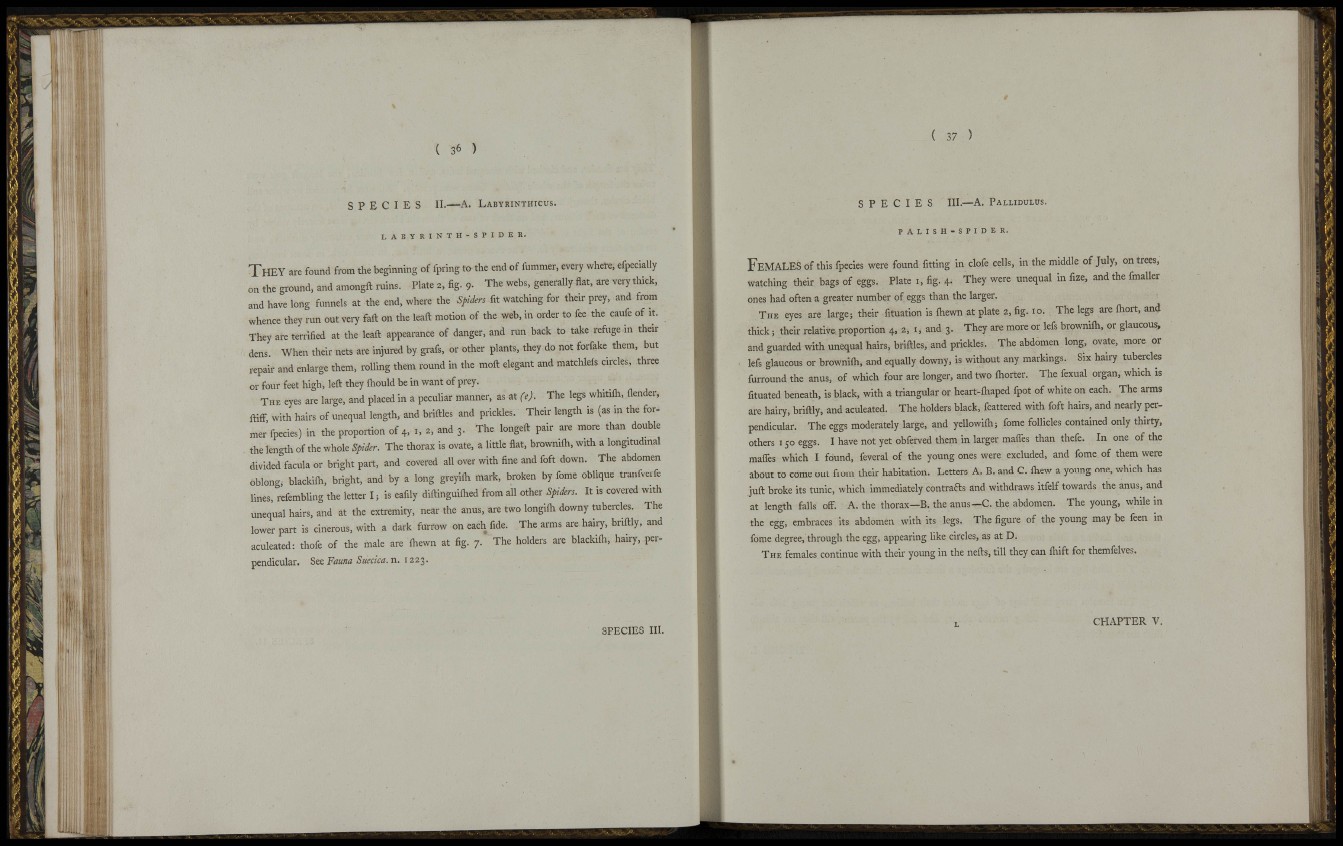
HI I:!
( 37 )
S P E C I E S II.—A. LABYRINTHICUS. S P E C I E S III.—A. PALLIDULUS.
I
L A B Y R I N T H - S P I D E R .
T H E Y are found from the beginning of fpring to the end of fummer, every where, efpecially
on the ground, and amongft ruins. Plate 2, fig. 9. The webs, generally flat, are very thick,
and have long funnels at the end, where the Spiders fit watching for their prey, and from
whence they run out very faft on the leaft motion of the web, in order to fee the caufe of it.
They are terrified at the leaft appearance of danger, and run back to take refuge in their
dens. When their nets are injured by grafs, or other plants, they do not forfake them, but
repair and enlarge them, rolling them round in the moft elegant and matchlels circles, three
or four feet high, left they Ihould be in want of prey.
THE eyes are large, and placed in a peculiar manner, as at R-;. The legs whitiih, flender,
ftiff with hairs of unequal length, and briftles and prickles. Their length is (as in the former
fpecies) in the proportion of 4, i, a, and 3. The longeft pair are more than double
the length of the whole Spider. The thorax is ovate, a little flat, browniih, with a longitudinal
divided facula or bright part, and covered all over with fine and foft down. The abdomen
oblong, blackiih, bright, and by a long greyiüi mark, broken by fome oblique tranfverfe
lines, refembling the letter I ; is eafily diftinguiihed from all other Spiders. It is covered with
unequal hairs, and at the extremity, near the anus, are two longiih downy tubercles. The
lower part is cinerous, with a dark furrow on each fide. The arms are hairy, briftly, and
aculeated: thofe of the male are ihewn at fig. 7. The holders are blackiih, hairy, perpendicular.
See Fauna Suecica. n. 1223.
P A L I S H - S P I D E R .
FEMALES of this fpecies were found fitting in clofe cells, in the middle of July, entrees,
watching their bags of eggs. Plate i, fig. 4. They were unequal in fize, and the fmaller
ones had often a greater number of eggs than the larger.
THE eyes are large; their fituation is ihewn at plate 2, fig. 10. The legs are ihort, and
thick; their relative proportion 4. 2. ' . and 3. They are more or lefs browniih, or glaucous,
and guarded with unequal hairs, briftles, and prickles. The abdomen long, ovate, more or
lefs glaucous or browniih, and equally downy, is without any markings. Six hairy tubercles
furround the anus, of which four are longer, and two ihorter. The fexual organ, which is
fituated beneath, is black, with a triangular or heart-fliaped fpot of white on each. The arms
are hairy, briftly, and aculeated. The holders black, fcattered with foft hairs, and nearly perpendicular.
The eggs moderately large, and yellowifh; fome follicles contained only thirty,
others x 50 eggs. I have not yet obferved them in larger maifes than thefe. In one of the
maflfes which I found, feveral of the young ones were excluded, and fome of them were
about to come out from their habitation. Letters A. B. and C. ihew a young one, which has
juft broke its tunic, which immediately contraes and withdraws itfelf towards the anus, and
at length falls oiF. A. the thorax—B. the anus—C. the abdomen. The young, while in
the egg, embraces its abdomen with its legs. The figure of the young may be feen in
fome degree, through the egg, appearing like circles, as at D.
THE females continue with their young in die nefts, till they can iliift for themfelves.
Ì
Í
SPECIES III.
CHAPTER V.
II.